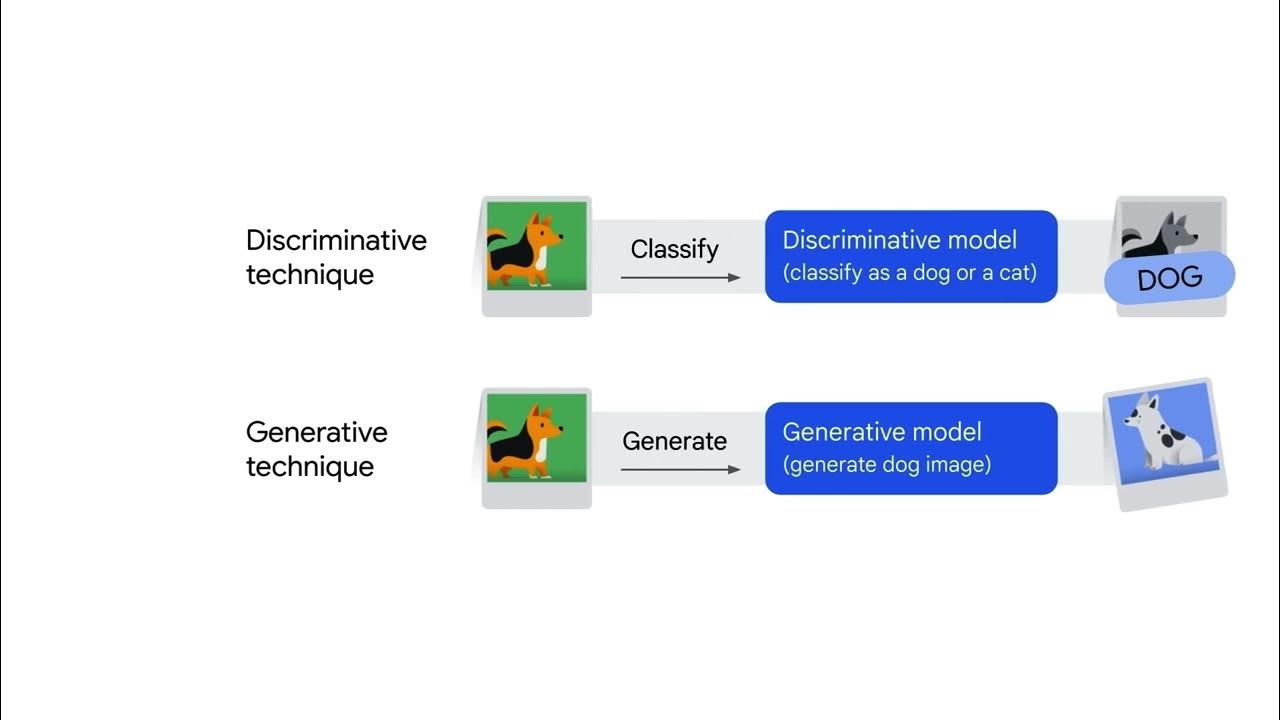Introduction to Generative AI
Summary
TLDRThis video script offers an in-depth introduction to Generative AI, explaining its definition, working principles, and applications. Dr. Gwendolyn Stripling, from Google Cloud, clarifies the distinction between AI, machine learning, and deep learning, highlighting Generative AI's role in creating new content using neural networks. The script delves into model types, discusses the importance of training data, and showcases tools like Generative AI Studio and PaLM API, emphasizing their potential to revolutionize industries.
Takeaways
- 🧠 Generative AI is a form of artificial intelligence that can create various types of content, including text, imagery, audio, and synthetic data.
- 🤖 AI is a branch of computer science focused on creating intelligent agents capable of reasoning, learning, and acting autonomously.
- 📚 Machine learning is a subfield of AI that allows systems to learn from input data without explicit programming.
- 🏷️ Supervised learning involves models trained on labeled data, while unsupervised learning deals with unlabeled data, focusing on discovery and clustering.
- 🧩 Deep learning is a subset of machine learning that uses artificial neural networks to process complex patterns, inspired by the human brain.
- 🔮 Generative models, unlike discriminative models, generate new data instances based on learned probability distributions of existing data.
- 📈 The Generative AI process involves training a 'foundation model' that can generate new content across various data types, such as text, images, and audio.
- 🛠️ Traditional programming is being replaced by neural networks and generative models, allowing for more dynamic and creative content generation.
- 🌐 Large language models (LLMs) like PaLM and LaMDA ingest vast amounts of data to create foundation models capable of generating human-like text.
- 🤝 The power of Generative AI is greatly influenced by the use of Transformers, which enable efficient processing through parallelization and the handling of large datasets.
- 🛑 'Hallucinations' in Transformers refer to nonsensical or incorrect text generated by the model, which can be mitigated through better training data and constraints.
Q & A
What is Generative AI and what types of content can it produce?
-Generative AI is a type of artificial intelligence technology that can produce various types of content, including text, imagery, audio, and synthetic data.
How is AI defined in the context of this script?
-AI is defined as a branch of computer science that deals with the creation of intelligent agents, which are systems that can reason, learn, and act autonomously, essentially building machines that think and act like humans.
What is the relationship between AI and Machine Learning?
-Machine Learning is a subfield of AI. It is a program or system that trains a model from input data, allowing the computer to learn without explicit programming.
What distinguishes supervised machine learning models from unsupervised ones?
-The key difference is that supervised models use labeled data with tags like names, types, or numbers, while unsupervised models work with unlabeled data and focus on discovery and grouping within the data.
How does Generative AI fit into the broader AI discipline?
-Generative AI is a subset of deep learning, which uses artificial neural networks and can process both labeled and unlabeled data using supervised, unsupervised, and semi-supervised methods.
What is the difference between generative and discriminative models in the context of AI?
-A discriminative model classifies or predicts labels for data points, typically trained on labeled data. A generative model generates new data instances based on a learned probability distribution of existing data.
What is the role of Transformers in Generative AI?
-Transformers, introduced in 2018, are a type of neural network architecture that consists of an encoder and decoder, allowing for efficient processing of data and enabling the generation of new content.
What are 'hallucinations' in the context of Transformers and why can they be a problem?
-Hallucinations refer to nonsensical or grammatically incorrect words or phrases generated by the model. They can be caused by insufficient training data, noisy data, lack of context, or constraints, and can lead to difficult-to-understand or misleading outputs.
How can prompt design help in controlling the output of a Generative AI model?
-Prompt design involves creating a short piece of text that, when given as input to a large language model, can guide the model to generate the desired output in a controlled and contextual manner.
What is a foundation model and how can it be adapted for various tasks?
-A foundation model is a large AI model pre-trained on a vast amount of data and designed to be adapted or fine-tuned for a wide range of downstream tasks such as sentiment analysis, image captioning, and object recognition.
What are some applications of Generative AI mentioned in the script?
-Some applications include code generation, sentiment analysis, image and video generation, chatbots, digital assistants, custom search engines, knowledge bases, and training applications.
Outlines

Этот раздел доступен только подписчикам платных тарифов. Пожалуйста, перейдите на платный тариф для доступа.
Перейти на платный тарифMindmap

Этот раздел доступен только подписчикам платных тарифов. Пожалуйста, перейдите на платный тариф для доступа.
Перейти на платный тарифKeywords

Этот раздел доступен только подписчикам платных тарифов. Пожалуйста, перейдите на платный тариф для доступа.
Перейти на платный тарифHighlights

Этот раздел доступен только подписчикам платных тарифов. Пожалуйста, перейдите на платный тариф для доступа.
Перейти на платный тарифTranscripts

Этот раздел доступен только подписчикам платных тарифов. Пожалуйста, перейдите на платный тариф для доступа.
Перейти на платный тарифПосмотреть больше похожих видео
5.0 / 5 (0 votes)






